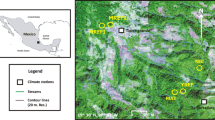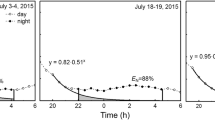Abstract
Evidence exists of nighttime transpiration and its potential impact on plant/water relations for species in a diversity of ecosystems. However, relevant data related to typical desert riparian forest species remains limited. Accordingly, we measured sap flow velocity of Populus euphratica using the heat ratio method between 2012 and 2014. Nocturnal stem sap flow was separated into nighttime and stem refilling using the “forecasted refilling” method. Nighttime transpiration was observed for each phenophase. The highest value was during the full foliation period but lowest during leaf expansion and defoliation periods. The contribution of nighttime transpiration to daytime transpiration was an average of 15% but this was comparatively higher during the defoliation period. Relationships between nighttime transpiration, vapor pressure deficits, and air temperatures were more closely associated than with wind speed in all phenophases. Moreover, we found that nighttime transpiration linearly correlated to vapour pressure deficit during the first and the full foliation periods, but nighttime transpiration showed exponential correlations to air temperatures during the same phenophases. Additionally, environmental drivers of transpiration were significantly different between nighttime and daytime (P < 0.05). Driving forces behind nighttime transpiration were characterized by many factors, and integrated impacts between these multiple environmental factors were complex. Future studies should focus on these integrated impacts on nighttime transpiration, and the physiological mechanisms of nighttime transpiration should be investigated, given that this could also influence its occurrence and magnitude during different phenophases.





Similar content being viewed by others
References
Aishan T, Halik Ü, Betz F (2016) Modeling height-diameter relationship for Populus euphratica in the Tarim riparian forest ecosystem, Northwest China. J For Res 27(4):889–900
Benyon RG (1999) Nighttime water use in an irrigated Eucalyptus grandis plantation. Tree Physiol 19:853–859
Bucci SJ, Scholz FG, Goldstein G (2004) Processes preventing nocturnal equilibration between leaf and soil water potential in tropical savanna woody species. Tree Physiol 24:1119–1127
Bucci SJ, Goldstein G, Meinzer FC (2005) Mechanisms contributing to seasonal homeostasis of minimum leaf water potential and predawn disequilibrium between soil and plant water potential in Neotropical savanna trees. Trees 19:296–304
Buckley TN, Turnbull TL, Pfautsch S (2011) Nocturnal water loss in mature subalpine Eucalyptus delegatensis tall open forests and adjacent E. pauciflora woodlands. Ecol Evol 20:435–450
Burgess SSO, Dawson TE (2004) The contribution of fog to the water relations of Sequoia sempervirens (D. Don): foliar uptake and prevention of dehydration. Plant Cell Environ 27:1023–1034
Burgess SSO, Adams MA, Turner NC (1998) The redistribution of soil water by tree root systems. Oecologia 115:306–311
Burgess SSO, Adams MA, Turner NC (2001) An improved heat pulse method to measure low and reverse rates of sap flow in woody plants. Tree Physiol 21:589–598
Caird MA, Richards JH, Hsiao TC (2007) Significant transpiration and water loss occurs throughout the night in field-grown tomato. Funct Plant Biol 34:172–177
Daley MJ, Phillips NG (2006) Interspecific variation in nighttime transpiration and stomatal conductance in a mixed New England deciduous forest. Tree Physiol 26:411–419
Dawson TE, Burgess SSO, Tu KP (2007) Nighttime transpiration in woody plants from contrasting ecosystems. Tree Physiol 27:561–575
Donovan LA, Grise DJ, West JB, Pappert RA (1999) Predawn disequilibrium between plant and soil water potentials in two cold-desert shrubs. Oecologia 120:209–217
Dunlop M, Brown PR (2008) Implications of climate change for Australia’s National Reserve System: a preliminary assessment. Report to the Department of Climate Change, February Department of Climate Change, Canberra, Australia
Fisher JB, Baldocchi DD, Misson L (2007) What the towers don’t see at night: nocturnal sap flow in trees and shrubs at two AmeriFlux sites in California. Tree Physiol 27:597–610
Gao GL, Zhang XY, Yu TF (2016) Evapotranspiration of a Populuseu phratica forest during the growing season in an extremely arid region of northwest China using the Shuttle worth–Wallace model. J For Res 27(4):879–887
Green SR, McNaughton KG, Clothier BE (1989) Observations of nighttime water use in kiwifruit vines and apple trees. Agric For Meteorol 48:251–261
Gutierrez MV, Meinzer FC, Grantz DA (1994) Regulation of transpiration in coffee hedgerows: covariation of environmental variables and apparent responses of stomata to wind and humidity. Plant Cell Environ 17:1305–1313
Howard AR, Donovan LA (2007) Helianthus nighttime conductance and transpiration respond to soil water but not nutrient availability. Plant Physiol 143(1):145–155
Howard AR, VanIersel MW, Richards JH (2009) Night-time transpiration can decrease hydraulic redistribution. Plant Cell Environ 32:1060–1070
Kavanagh KL, Pangle R, Schotzko AD (2007) Nocturnal transpiration causing disequilibrium between soil and stem predawn water potential in mixed conifer forests of Idaho. Tree Physiol 27:621–629
Keyimu M, Halik Ü, Betz F (2018) Vitality variation and population structure of a riparian forest in the lower reaches of the Tarim River, NW China. J For Res 29(3):749–760
Kohler M, Schwendenmann L, Hoscher D (2010) Throughfall reduction in a cacao agroforest: tree water use and soil water budgeting. Agric For Meteorol 150:1079–1089
Marks CO, Lechowicz MJ (2007) The ecological and functional correlates of nocturnal transpiration. Tree Physiol 27:577–584
Marshall DC (1958) Measurement of sap flow in conifers by heat transport. Plant Physiol 33:385–396
Phillips NG, Lewis JD, Logan BA (2010) Inter- and intra-specific variation in nocturnal water transport in Eucalyptus. Tree Physiol 30:586–596
Scholz FG, Bucci SJ, Goldstein G (2007) Removal of nutrient limitations by long-term fertilization decreases nocturnal water loss in savanna trees. Tree Physiol 27:551–559
Si JH, Feng Q, Zhang XY (2007) Sap flow of Populus euphratica in a desert riparian forest in an extreme arid region during the growing season. J Integr Plant Biol 49(4):425–436
Si JH, Chang ZQ, Su YH (2008) Stomatal conductance characteristics of Populus euphratica leaves and response to environmental factors in the extreme arid region. Acta Botanica Boreali-Occidenalia Sin 28(1):125–130
Si JH, Feng Q, Yu TF (2014) Research advance in nighttime transpiration and its eco-hydrological implications. Adv Water Sci 25(6):907–914
Snyder KA, Richards JH, Donovan LA (2003) Nighttime conductance in C3 and C4 species: do plants lose water at night? J Exp Bot 54:861–865
Tateishi M, Shiiba Y, Inoue K, Kaji K, Otsuki K (2008) Spatial variation s in xylem sap flux density in evergreen oak trees with radial-porous wood: comparisons with anatomical observations. Trees 22:23–30
Vertessy RA, Hatton TJ, Reece P (1997) Estimating stand water use of large mountain ash trees and validation of the sap flow measurement technique. Tree Physiol 1(7):747–756
Whitehead D (1998) Regulation of stomatal conductance and transpiration in forest canopies. Tree Physiol 18(8–9):633–644
Yu TF, Feng Q, Si JH (2013) Patterns, magnitude, and controlling factors of hydraulic redistribution of soil water by Tamarix ramosissima roots. J Arid Land 5(3):396–407
Zeppel MD, Tissue T, Taylor D (2010) Rates of nocturnal transpiration in two evergreen temperate woodland species with different water-use strategies. Tree Physiol 30:988–1000
Zhao CY, Si JH, Feng Q (2014) Sap flow xylem of Populus euphraticain relation to environmental factors in the lower reaches of Heihe River. J Desert Res 34(3):718–724
Author information
Authors and Affiliations
Corresponding author
Additional information
Project funding: This study was financially supported by the Key Research Program of Frontier Sciences CAS (QYZDJ-SSW-DQC031), Key Project of the Chinese Academy of Sciences (KZZD-EW-04-05), the National Natural Science Foundation of China (91025024), and the “Western Light” project of the Chinese Academy of Science.
The online version is available at http://www.springerlink.com
Corresponding editor: Yu Lei.
Rights and permissions
About this article
Cite this article
Zhao, C., Si, J., Feng, Q. et al. Nighttime transpiration of Populus euphratica during different phenophases. J. For. Res. 30, 435–444 (2019). https://doi.org/10.1007/s11676-018-0672-z
Received:
Accepted:
Published:
Issue Date:
DOI: https://doi.org/10.1007/s11676-018-0672-z




